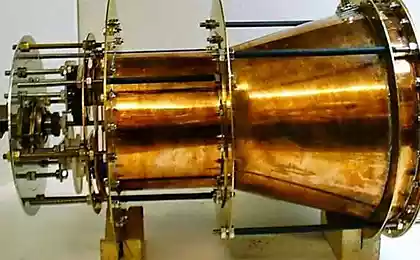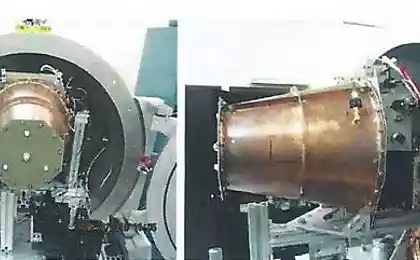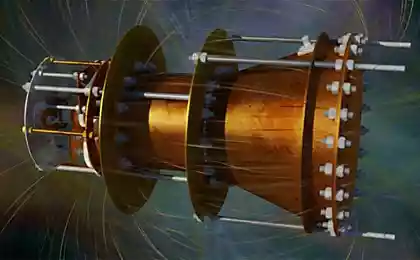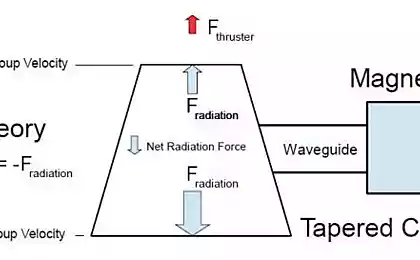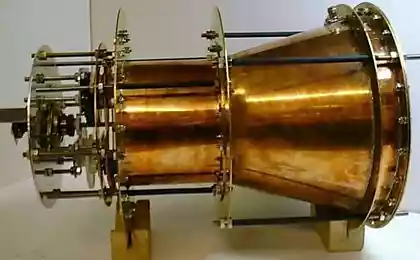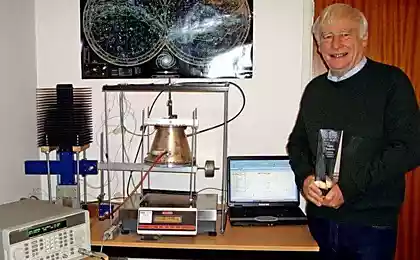756
Impossible engine emdrive, the Unruh effect, photons and inertia: an attempt to explain the inexplicable
English scholar from the University of Plymouth Makaloh Mike (Mike McCulloch) in his work he tried to explain the principle of the "impossible" engine EmDrive, which for several years now baffled experts. To do this, scientists have to explain this fundamental concept of physics, as inertia.
Engine EmDrive invented in the early 2000s, a British engineer Roger Scheuer. He presented to the public his idea about the engine, essentially consisting of a metallic truncated cone and the magnetron. According to his estimates, reflected in the design electromagnetic waves should create cravings without any reactive components.
Naturally, he was raised on laughter as the law of conservation of momentum can not create these devices. But, since 2008, and the experience of Chinese scientists, and then - a few enthusiastic engineers, and ending with the experiences of respected engineers from NASA, accumulated more and more evidence that this strange engine still running
.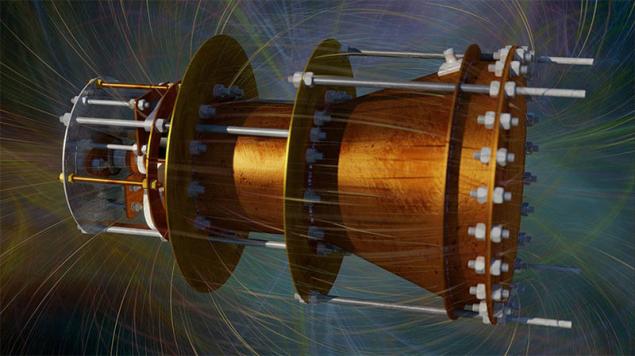
So far, the scientific world does not jump to conclusions - certainly it is not considered a confirmed fact of the engine performance, and there is no universally accepted explanation for this fact. Makaloh proposes to use for this purpose an exotic effect as Unruh radiation.
Since the school is well known that all objects with mass, there is such a property, as inertia. The mass inertia is even called the measure - is the ability to resist attempts to change the body of the speed or direction of movement. Or, in other words, the bodies remain in some frames of reference property in the state of rest or uniform motion in the absence or the mutual compensation of external influences.
But why is it there? On this question the answer is no. Makaloh recalled the Unruh effect, named after Bill Unruh of the University of British Columbia who discovered it in 1976.
Unruh demonstrated that the notion of vacuum depends on how the observer is moving through space-time. If you are around a stationary observer it is only vacuum, accelerating observer will see around a lot of particles in thermodynamic equilibrium, ie warm gas. Thus, the temperature of vacuum in the reference system of particles moving at standard terrestrial gravitational acceleration 9, 81 m / s ², according to the calculations is equal to 4 * 10-20 K.
In fact, after opening Ounrou vacuum can speak of only relative to some object. If the observer moves with acceleration, he observes around him heat radiation - or rather, black body radiation. A Makaloh believes that inertia - it is the pressure of the radiation on the body accelerating
. According to his calculations, at very small accelerations Unruh radiation wavelength obtained so large that exceeds the size of the observable universe. Therefore, the inertia does not increase continuously, and is quantized. Surprisingly, this strange theory explains very well the other strange effect - the span anomalies
. The span anomaly - a sudden increase in energy during gravity assist spacecraft around the Earth. This anomaly is observed as the Doppler frequency offset in the S-band and X-band telemetry and long. All this together resulted in a significant increase in neraschёtnoe speed to 13 mm / s during the flyby.
This anomaly was observed in 1990. The flyby spacecraft Galileo, created for the study of Jupiter and its satellites (increase rate of 4 mm / s); in 1998, the year - the spacecraft NEAR Shoemaker, sent in 1996 to the asteroid Eros (increase rate of 13 mm / s); in 1999 - Cassini (0 to 11 mm / s); in 2005, the year - Rosetta (2 mm / s)
. Makaloh thinks that these sudden jumps occurred at a time when increased acceleration, and the length of the Unruh radiation becomes small enough - at this point the spacecraft experienced a jump speed. Similarly works Casimir effect.
Further explanations Makaloha become more interesting: it assumes the presence of an inert mass of the photon. Since photons are reflected inside the test EmDrive housing, they experience and inertia. Only Ounrou emission wavelengths in this case will be very small. So small that it can fit in the conical motor housing.
And if it turns out that in the widest part of the cone is placed Unruh waves that do not fit in the narrow part, the inertia of the photons are reflected in all directions, it must change. And to maintain the momentum the system should create cravings. Makaloh conducted calculations and found that his theory is consistent with the values of the thrust obtained in experiments (at least in order of magnitude).
Most interesting is that it is possible to check the calculations in the next experiment EmDrive. If it is right, firstly, placing inside the dielectric cavity should increase engine thrust. Second, the change in the frequency of photons or motor geometry must change cravings, up to change the direction.
If this theory seems somewhat bold, at least because it contains unusual assumptions - that in fact still other suitable theories to explain the work emdrive, does not exist yet. Who knows, but the theory can explain the unusual may be the work of an unusual engine?
Author: Vyacheslav Golovanov
Engine EmDrive invented in the early 2000s, a British engineer Roger Scheuer. He presented to the public his idea about the engine, essentially consisting of a metallic truncated cone and the magnetron. According to his estimates, reflected in the design electromagnetic waves should create cravings without any reactive components.
Naturally, he was raised on laughter as the law of conservation of momentum can not create these devices. But, since 2008, and the experience of Chinese scientists, and then - a few enthusiastic engineers, and ending with the experiences of respected engineers from NASA, accumulated more and more evidence that this strange engine still running
.

So far, the scientific world does not jump to conclusions - certainly it is not considered a confirmed fact of the engine performance, and there is no universally accepted explanation for this fact. Makaloh proposes to use for this purpose an exotic effect as Unruh radiation.
Since the school is well known that all objects with mass, there is such a property, as inertia. The mass inertia is even called the measure - is the ability to resist attempts to change the body of the speed or direction of movement. Or, in other words, the bodies remain in some frames of reference property in the state of rest or uniform motion in the absence or the mutual compensation of external influences.
But why is it there? On this question the answer is no. Makaloh recalled the Unruh effect, named after Bill Unruh of the University of British Columbia who discovered it in 1976.
Unruh demonstrated that the notion of vacuum depends on how the observer is moving through space-time. If you are around a stationary observer it is only vacuum, accelerating observer will see around a lot of particles in thermodynamic equilibrium, ie warm gas. Thus, the temperature of vacuum in the reference system of particles moving at standard terrestrial gravitational acceleration 9, 81 m / s ², according to the calculations is equal to 4 * 10-20 K.
In fact, after opening Ounrou vacuum can speak of only relative to some object. If the observer moves with acceleration, he observes around him heat radiation - or rather, black body radiation. A Makaloh believes that inertia - it is the pressure of the radiation on the body accelerating
. According to his calculations, at very small accelerations Unruh radiation wavelength obtained so large that exceeds the size of the observable universe. Therefore, the inertia does not increase continuously, and is quantized. Surprisingly, this strange theory explains very well the other strange effect - the span anomalies
. The span anomaly - a sudden increase in energy during gravity assist spacecraft around the Earth. This anomaly is observed as the Doppler frequency offset in the S-band and X-band telemetry and long. All this together resulted in a significant increase in neraschёtnoe speed to 13 mm / s during the flyby.
This anomaly was observed in 1990. The flyby spacecraft Galileo, created for the study of Jupiter and its satellites (increase rate of 4 mm / s); in 1998, the year - the spacecraft NEAR Shoemaker, sent in 1996 to the asteroid Eros (increase rate of 13 mm / s); in 1999 - Cassini (0 to 11 mm / s); in 2005, the year - Rosetta (2 mm / s)
. Makaloh thinks that these sudden jumps occurred at a time when increased acceleration, and the length of the Unruh radiation becomes small enough - at this point the spacecraft experienced a jump speed. Similarly works Casimir effect.
Further explanations Makaloha become more interesting: it assumes the presence of an inert mass of the photon. Since photons are reflected inside the test EmDrive housing, they experience and inertia. Only Ounrou emission wavelengths in this case will be very small. So small that it can fit in the conical motor housing.
And if it turns out that in the widest part of the cone is placed Unruh waves that do not fit in the narrow part, the inertia of the photons are reflected in all directions, it must change. And to maintain the momentum the system should create cravings. Makaloh conducted calculations and found that his theory is consistent with the values of the thrust obtained in experiments (at least in order of magnitude).
Most interesting is that it is possible to check the calculations in the next experiment EmDrive. If it is right, firstly, placing inside the dielectric cavity should increase engine thrust. Second, the change in the frequency of photons or motor geometry must change cravings, up to change the direction.
If this theory seems somewhat bold, at least because it contains unusual assumptions - that in fact still other suitable theories to explain the work emdrive, does not exist yet. Who knows, but the theory can explain the unusual may be the work of an unusual engine?
Author: Vyacheslav Golovanov
